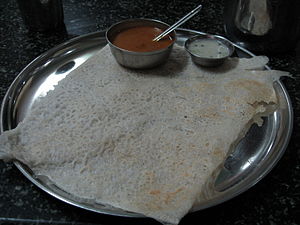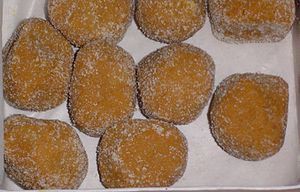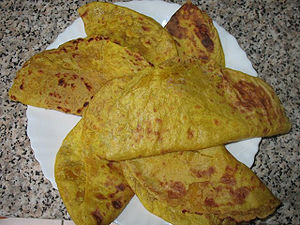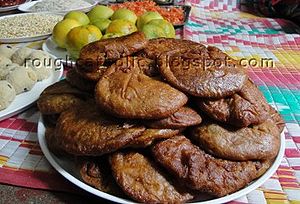- Cuisine of Karnataka
-

This article is part of the series
Indian cuisineRegional cuisinesNorth India
Main article
Awadhi • Punjabi • Kumauni • Mughlai • Kashmiri • Rajasthani • Uttar PradeshiNorth-East India
Assamese • Meghalayan • Manipuri • Naga • Sikkimese • Tripuri • ArunachaleseSouth India
Main article
Andhra • Karnataka • Kerala • Tamil • Hyderabadi • Udupi • Mangalorean • Saraswat • Mangalorean CatholicEast India
Bengali • Oriya • Bihari • BhojpuriWest India
Goan • Gujarati • Marathi • Malvani & Konkani • Sindhi • ParsiOther
Indian Chinese • Nepali • Jain (Satvika) • Anglo-Indian • Chettinad • Fast foodIngredients and types of foodMain dishes • Desserts • Bread • Drinks • Snacks • Spices • Condiments
See alsoHistory • Etiquette • Indian chefs • Cookbook: Cuisine of India
 India portal
India portalThe cuisine of Karnataka includes many vegetarian and non-vegetarian cuisines. The varieties reflect influences from and to the food habits of many regions and communities from the three neighbouring South Indian states, as well as the state of Maharashtra to its north. Some typical dishes include Bisi bele bath, Jolada rotti, Chapati, Ragi rotti, Akki rotti, Saaru, Huli, Vangi Bath, Khara Bath, Kesari Bath, Davanagere Benne Dosa, Ragi mudde, and Uppittu. The famous Masala Dosa traces its origin to Udupi cuisine. Plain and Rave Idli, MysoreMasala Dosa and Maddur Vade are popular in South Karnataka. Coorg district is famous for spicy varieties of pork curries while coastal Karnataka boasts of many tasty seafood specialities. Among sweets, Mysore Pak, Holige, or, Obbattu, Dharwad pedha, Chiroti are well known.
Although the ingredients differ from one region to another, a typical Kannadiga Oota (Kannadiga meal) includes the following dishes in the order specified and is served on a banana leaf: Uppu(salt), Kosambari, Pickle, Palya, Gojju, Raita, Dessert (Yes, it is a tradition to start your meal with a dessert - Paaysa), Thovve, Chitranna, Rice and Ghee
After serving ghee to everyone, one may start the meal. This is done to ensure that everyone seated has been served all the dishes completely.
What follows next is a series of soup like dishes such as Saaru, Muddipalya, Majjige Huli or Kootu which is eaten with hot rice. Gojju or raita is served next; two or three desserts are served; fried dishes such as Aambode or Bonda are served next. The meal ends with a serving of curd rice.
It is believed that every meal is a wholesome meal containing essential components of a healthy meal such as proteins, carbohydrates and vitamins.
There is some diversity in core food habits of North and South Karnataka. While northern-style dishes have jola and rice as the primary cereals the south uses ragi and rice.
Contents
North Karnataka cuisine
The North Karnataka cuisine can be primarily found in the northern districts of Karnataka, including Bidar, Kalburgi, Yadgir, Vijapura, Bagalakote, Belagaavi, Raayachooru, Dharwad, Davangere, Gadag, Haveri, Koppala and western and northern areas of Ballari. The cuisine is also considered a specialty in the cities of Southern Karnataka like Bengaluru and Mysuru, with several restaurants offering this cuisine to meet the growing demand.
North Karnataka meal
The following is the typical menu of a vegetarian Northern Karnataka meal :
- Rotti / Bhakri - Thin flatbread usually made from Jowar flour, baked on fire or iron skillet. Bajra and Wheat flour is also used as an alternative.
- Enne-gai / Tumbu-gai - Small badane kaayi bulbs stuffed with dry stuffing including ground peanut, ground sesame, ginger, garlic, garam masala, salt, and then sauteed with onions and other spices. Aubergine is also substituted with any other suitable vegetable.
- Shenga/Ellu chutney - A variety of powder/dry chutney made from ground peanut or sesame.
- Kempu Khaara, also called "Ranjaka" - chutney paste made with/of red chillis, consumed as a condiment
- Kosambari
- Bele or kaaLu palya - Split, whole or sprouted kadale, hesaru, togari or masoor, cooked with greens such as methi, spinach, sabbasige and spring onion, and sauteed with onions, ginger, garlic and other spices.
- mosaru bajji or raitha - salad involving yogurt
- Raw Salads - of spring onion, onion, green chili, methi leaves, sometimes with oggaraNe of sasive and/or jeerige
- Anna - Rice
- Saaru - Tangy soup made with pepper, cumin, coriander seeds tomatoes and/or tamarind.
- Happala
- Mosaru and majjige
- beNNe or tuppa
- Jhunuka or - Salty, Masala Cakes made from Channa Dal powder
- Herbs - Like, Spinach, Methi and Hakkarike
- Vegetables - Onions, Green Chilly, Radish, Cucumbar and Carrots
South Karnataka cuisine
The South Karnataka or old Mysore region also known as Bayaluseeme or the plains including the present-day Kolara, Bengalooru, Mysooru, Tumakooru, Mandya, Haasana, Chamarajanagara. Ragi and Rice are the most important staple grains, Jowar and bajra are also cultivated and consumed in the drier parts of the region. The first meal of the day is the breakfast which is quite substantial. Regular meals consists of Ragi mudde or steamed dumpling made from ragi flour, a curry to roll bits of the dumpling often called Saaru, Rice and Yogurt. Optional accompaniments include a salad called Kosambari, various Palyas (fried, boiled or sauteed spicy vegetables) and assorted pickles.
Formal vegetarian meals are usually served in a particular order and required to be consumed in a particular order as well. These meals are served on Plantain leaves or Mutuka leaves, dry Tendu[disambiguation needed
 ]-like leaves staples together into big circular discs. First accompaniments are served which includes variety of Palya, Kosambari, sweet-savory gojju, hot spicy chutney Pickles, bajji, bonda, vade, Papads. The first course alternated between sweets and rice preparation. The second course is a set of curries to be consumed with rice. It generally starts with Tovve, a mild lentil dish laced with ghee, Majjige Huli, vegetables simmered in a mild yogurt sauce, followed by Huli, lentils and vegetables spiced and tempered with ghee, mustard, asafoetida and curry leaves. This is followed by tili Saaru which is a thin lentil stock spiced and laced with ghee and curry leaves. The final course of the meal is rice and curd with pickles. Buttermilk is also served to be consumed at the end of the meal.
]-like leaves staples together into big circular discs. First accompaniments are served which includes variety of Palya, Kosambari, sweet-savory gojju, hot spicy chutney Pickles, bajji, bonda, vade, Papads. The first course alternated between sweets and rice preparation. The second course is a set of curries to be consumed with rice. It generally starts with Tovve, a mild lentil dish laced with ghee, Majjige Huli, vegetables simmered in a mild yogurt sauce, followed by Huli, lentils and vegetables spiced and tempered with ghee, mustard, asafoetida and curry leaves. This is followed by tili Saaru which is a thin lentil stock spiced and laced with ghee and curry leaves. The final course of the meal is rice and curd with pickles. Buttermilk is also served to be consumed at the end of the meal.The Hilly district of Kodagu (Coorg) also has its own unique cuisine which includes spicy meat (Pandi (Pork) Curry, Chicken, Mutton), Kadumbutt(Round balls made up of rice), Paputt, Thaliyaputt. The spicy meat curries derives a tangy taste from Kokum Kachampuli.
Karnataka cuisine-common to all regions
Some common vegetarian dishes prepared on a regular basis are:
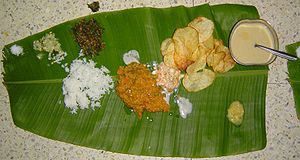 Lunch served on a plantain leaf
Lunch served on a plantain leaf
Rice dishes
- Bisi bele bath - rice cooked with dal, vegetables and spices; like huli with rice, but often richer
- Vaangi baath - cooked rice mixed with vegetables cooked in oil and spices; the vegetables are usually made into a palya beforehand and the vaangi baath mixed before serving
- Chitranna - cooked rice flavoured with spices, particularly oil-popped mustard seeds and turmeric
- Mosaranna - curd rice sometimes given a fried spicy touch with fried lentils and oil-popped mustard seeds.
- Puliyogare - cooked rice flavoured with spicy tamarind paste
- Maavinkaayi chitranna - cooked rice flavoured with raw green mango and spices
- Nimbekaayi chitranna - cooked rice flavoured with lemon and spices
- Avalakki - Akki (means rice), avalakki is baked flat rice that is soaked briefly and stirfried with cumin seeds, turmeric powder, peanuts, onions, green chillies, garnished with shredded coconuts and cilantro leaves.
- Mandakki - Puffed rice that is soaked briefly and stirfried with cumin seeds, turmeric powder, peanuts, roasted ground grams, onions, green chillies, garnished with shredded coconuts and cilantro leaves.
"Breads"
- Ragi rotti - A flat thick pancake made with ragi dough and flavoured with chillies and onions; the dough is shaped and flattened by hand.
- Akki rotti - A thick, flat pancake-like dish made with a dough of rice flour, chillies, onions and salt; the dough is shaped and flattened by hand.
- Jolada rotti - A flat pancake dish made with a dough of Sorghum flour and salt; the dough is shaped and flattened by hand. Jowar may be sometimes replaced with bajra.
- Ragi mudde - Steamed dumplings made by adding ragi flour to boiling water.
- Gunpongalu - Also known as Gundupongla, Mane Kaavali (skillet with houses), or Poddu. It is made with a rice batter (similar to dose) and cooked in a special skillet with compartments.
- Chapathi - flat unleavened bread made from wheat flour, water, oil and salt. Unlike rottis, the dough rolled with a rolling-pin.
Chutneys
- Kadalekaayi chutney
- Hurali chutney
- Kaayi chutney- grated coconut ground with dal (kadale) salted and garnished with oil-fried mustard and curry leaves
- Kaayi chutney (green) - grated coconut ground with dal, green chillies and coriander salted and garnished with oil-fried mustard and curry leaves
- Kaayi chutney (red) - grated coconut chutney ground with dal and dried red chillies salted and garnished with oil-fried mustard and curry leaves
- Maavina chutney - grated raw green mango ground with grated coconut, dal, salted and garnished oil-fried mustard and curry leaves.
- Heerekai chutney - grated ridge-gourd peel ground with grated coconut, dal, salted and garnished oil-fried mustard and curry leaves.
- Eerulli chutney - grated onion peel ground with grated coconut, dal, salted and garnished oil-fried mustard and curry leaves.
- Uddina Bele chutney - Fried Black Gram Dal with Tamarind, Red Chillies, salted and garnished oil-fried mustard and curry leaves.
- pudina chutney-fry pudina leaves along onion, groundnut, black gram, green chilli, tamrind.add sugar and grind to fine paste.
Palya or side dishes
- Hurali kaayi palya
- Hurali palya
- Hurali appala
- Badnekaayi palya
- Bendekaayi palya
- Allugade palya
Kosambari
A salad prepared using simple ingredients such as lentils, green chillies and finely chopped coriander. The dish is generally finished with a tempering of mustard seeds and asafotida. Common variants include kosambari made with the above ingredients in addition to grated cucumber or carrot.
Sweet and spicy dishes
- Menasinakaayi gojju
- HuNuse gojju - made with tamarind
- Bendekaayi gojju - boiled ladies-finger vegetable (okra) cooked in a gravy sweetend with jaggery and soured by tamarind.
- Tomato gojju - cooked cut or mashed tomato with a sweet-sour gravy.
- EeruLLi (Onion) and Tomato gojju - cooked cut or mashed tomato mixed with cut onion with a sweet-sour gravy.
- Haagalakaayi gojju - Bittergourd pieces marinated with salt and turmeric to remove some bitterness cooked with a sweet and sour gravy.
- Thondekaayi gojju
Saaru (Main course)
See also: Saaru- Huli- Combination of vegetables and lentils simmered with spices, coconut, tamarind and seasoned with Ghee, asafoetida, curry leaves and mustard, it is an integral part of every formal meal.
- Majjige Huli- Cooked vegetables simmered in yogurt with coconut, spices, asafoetida, curry leaves and mustard.
- Tovve- Mushy lentils cooked till creamy, spiked with spices and Ghee. Vegetables are also added to this dish like Ridged gourd, cucumber etc.
- Obbatinna saaru - made from the left over broth while preparing the sweet obbattu.
- Bas saaru - made from the broth of boiled lentils and spring beans
- Mosoppinna/HuLisoppu saaru - made from lentils and spinach
- Maskai- Combination of vegetables cooked and mashed with spices and seasoning.
- meNasina saaru - rasam made from pepper, turmeric, and other spices
- BeLe saaru - has toor dal as one of the ingredients
- kaaLinna saaru- Legumes cooked with coconut, spices, tamarind and tempered with asafoetida, curry leaves and mustard. Popular legumes include Kadale kaalu or Chickpeas, Alasande Kaalu black eye peas, Hesaru kaalu moong beans, Hurali kaalu Horse gram, Avare kaalu Indian beans
- Haagalakaayi saaru: Haagalakai, the Indian bitter gourd is simmered with coconut, tamarind and spices and spiked with Jaggery and asafoetida, curry leaves and mustard The bitterness of the gourd is cut through by the sweetness of the jaggery and tartness of the tamarind.
- Gojju- traditionally this is thicker than the Saaru but thinner than chutney. It is served with hot rice and is sweet, tangy and spicy. It is served in between courses as a palate cleanser. It is made from diverse ingredients including eggplants, okra, fenugreek, tamarind, pineapple, bitter gourd, tomatoes, lemon-lime, etc.
- Tambli - A yogurt based cold dish served with hot gravy. Optional ingredients in this dish includes vegetables and greens.
- Fish / Mutton / Chicken Saaru - A very famous local curry made mainly from assorted spices and meats. Often mixed and eaten with Ragi Balls and Rice or Bhakri
Sweets
- Huggi - cooked rice and kadale or hesaru, with coconut, milk, elakki and sweetened with bella (jaggery)
- GiNNu - sweetened, flavoured and steam boiled colostrum of cow, buffalo or goat
- Kajjaya - Rice and jaggery fritters deep fried in Ghee.
- Kadabu - deep fried (kari kadubu) or steamed pastry with assorted sweet filling.
- karjikaayi - deep fried crisp pastry with dry sweet filling
- unde - ball shaped sweets with the following variations :
- chikkina unDe - eLLu and bella
- chigaLi unDe - made from ellu
- rave unDe - made from semolina
- shenga unDe - made from peanut
- mandakki unDe - made from mandakki
- avalakki unDe - made from avalakki
- Ladoo - made of deep fried chickpea flour droplets and formed into balls that are dipped in sugar syrup.
- Hesarunde Moong dal ladoo.
- Godhiunde- made from Wheat
- Gulaadike Unde- made from Maida and Sugar - A Davangere speciality,
- Besanunde - made from besan
- tambittu - made from rice or wheat flour and jaggery.
- sikkinunde - made from jaggery, dried coconut and maida .
- beLe - made from split kadale or hesaru
- Jeerige
- Gasa-gase
- Sabbakki or Seeme Akki
- Shavige
- Anna
- Halasu
- Rave
- Nuts like cashew and almond, and dry fruits like raisins.
- obbattu or hOLige - stuffed or plain sweet flat bread/pancake/crepe with variations including :
- beLe - made from togari or kadale beLe.
- kaayi - The filling is made from coconut and jaggery
- sakkare -Filling made of sugar and desiccated coconut
- shenga - The filling is made of peanuts and jaggery. In Northern Karnataka, this variety is called kaayi hOLige, the kaayi referring to peanut (as opposed to coconut in Southern Karnataka).
- sakkare achhu - little sugar statues/toys made during Sankranti
- Haalubaayi - A fudge made with ground rice, jaggery and coconut.
- mysore pak- A fudge made with Chickpea flour, sugar and ghee.
- dharwad pedha- Milk scalded and thickened with sugar. Synonymous with Dharwad
- karadantu - Gokak town in Belgaum district of Karnataka is famous for the karadantu, the most famous form has a mixture of dry fruits and edible gum.
- sheekaraNi - pulp of ripe fruit (usually mango or banana) with additions such as sugar, elakki, jaakayi, jaapatri, milk, etc.
- Damrottu - Ash gourd toasted in ghee and simmered with sugar, milk solids and sweet spices
- Kunda - prepared from thickened milk, a speciality from BeLagaavi
- Badushah or Suralipoori
- Senige Huggi - A very famous sweet made during diwali in Shikaripur near Shimoga
- Sweet Pastries - The following can be grouped together. These are often accompanied by milled sugar, and/or warm milk flavoured with saffron and almonds.
- mandige - huge flat leavened pastry. It is quite a treat to watch chefs making large (>36 inches in diameter) pastries with bare hands and baking them on upturned clay pots over fire.
- This is an ancient dish mentioned in a few inscriptions as the Sanskritised mandaka. For instance, a Western Chalukya inscription of A.D. 1121 mentions that Govinda-Dandadhipa, a famous general of Vikramaditya VI, is said to have made a provision for offering this dish as naivedya to Brahma, Vishnu and Maheshvara, at Pauthage.[1]
- chiroti, pheni - fluffy and leavened pastry, sometimes called padaru pheni because it is leavened.
- shaavige chiroti - vermicelli pastry.
- kesaribhath, Sira - This is made of rice (or semolina in southern karnataka) cooked with sugar/jaggery, cardamom, saffron, milk, dry fruits (mostly raisins), and sometimes fresh fruits like banana, mango and pineapple. Popularly colored yellow/orange/saffron or left white. In North Karnataka, the semolina version is called Sihi Sajjige or Sheera or Sira; kesaribhath usually refers to the rice version.
- Hayagreeva - A chickpea based dessert prepared on special occasions; popular amongst the Maadhwa community
- Paramanna - Rice pudding with Ghee and Jaggery
- Mamu Puri - Flour, Ghee, Sugar, Khoa, first khoa is packed between 2 halves of chapati then fried. It is exported mainly to gulf.
- Maldi - A delicious sweet dish made of powdered 'baked wheat roties', poppy seed, jaggery, hurakadle (daria), and served with ghee. It is a must sweet on the occasion of marriages .
Pickles
Pickles are usually raw seasoned vegetables and sea food, but there are cooked varieties as well called Bisi Uppinakayi (hot pickle). The seasoning varies from plain salt to spices like green chilli, red chilli powder, black pepper, whole and powdered mustard seeds, coriander seeds, etc. They significantly differ from North Indian pickles or achar in that considerably less oil is usually used in the pickles; salt is the main preservative.
- Mavinkayi - Raw green mango
- Midi Mavinkaayi - Immature raw mangoes, usually used whole
- Amtekayi
- Nimbekayi - Whole and sliced lemon and lime
- Gaja Nimbekayi - A larger variety of lemon, resembling a grape fruit
- Bettada Nellikayi
- Nellikayi
- Tomato
- Heralikayi - a green citrus fruit, only the peel is used in the pickle.
- Hagalakayi - bitter gourd
- Prawn, shrimp and crab, especially in coastal areas
Snacks
- Bonda or Bajji - deep fried vegetables (and sometimes chicken and seafood) in batter
- Vadey - Ambode, Sabbakki vadey, Bele vadey etc.
- Chakkuli
- Nippattu
- Kodubale
- Khaara Mandakki - Puffed rice with Hot Boondi and Khara
- Aloo Bonda
- baaLaka - deep fried vegetable and fruit chips or wafers. The vegetables are usually dried and seasoned with spices, and even butter milk. Common candidates are potato, sweet potato, yam, cassava, ripe jack fruit, banana, plantain, chilli, bitter gourd, varieties of suitable green bean pods (usually gori kaayi/chaLLe kaayi), etc.
Udupi cuisine
Main article: Udupi cuisineUdupi cuisine takes its name from Udupi, a city on west coast of Karnataka. Udupi cuisine has its origin in Ashta mathas of Udupi founded by Shri Madhvacharya. Its core is a vast range of creative dishes emphasizing local vegetables and fruits.
Malenadu cuisine
The Malenadu of Karnataka can be culturally (on basis food culture) can be clearly divided as south malnad comprising Norhtern Somawarpete in Notrth Kodagu, Sakaleshapura, Mudigere, southern part of chickamagaluru taluk and western part of Belur and Alur taluks in Hassan. Central malnad consisting of chickamagalur, Koppa, malnad region of Shivmoga, and western ghat regions of Uttara Kannada. Even though Western ghat regions of Uttara knnada and Belagavi can be considered as Northern malnad the food culture of these regions is unaware to the rest of Malnad, may be due to inadequate communication with the other parts of malnad and Karnataka. Although many refer to the malenadu cuisine as an amalgam of Coorgi and Mangalorean cuisine, it has its own distinct style. And moreover Malenaadigaru(people hailing from Malnad) are considered to be natives to these part of Karnataka when compared with Coorgies( believed to be Greek soldires of Alexandar's era) and Bunts and Shetty's( Coastal, Mangalore, people who are claimed to be migrants, (Aarya's) from Northern India). So rather Malenaadu cuisine has traveled to the kitchens of Kodavas and Bunts would be a sensible line. The word "Malenaadu" means "land of mountain ranges". The cuisine is heavily influenced by the variety of fruits and vegetables available in the rich forests of western ghats. The ingredients like tender bamboo shoots, colocassia leaves, turmeric leaves, raw jackfruit are easily found in the Sahyadri ranges. Steaming is a favored the method of cooking in malenaadu. More often than not there is minimal use of oils in malenaadu cuisine.
- Kaalu kadabu- small kadubus (dumplings) as small as Kaalu (beans) made by pounding water washed rice into powder and then steamed to make it enouigh sticky to make dumplings. Once the kadubus (thousands in number) are made is given typical malnad masale (red chili, oil, mustard, graped coconut, jeera, little tamrind juice, curry leaves, salt to taste, etc.) and served hot with hot thuppa (homemade ghee from cow's or buffalo's milk). Prepared around the region of Hanubalu, in Sakaleshpura taluk of Hassan district.
- Chattituttu- An evenning snack ususlly prepared by grinding rice with other ingriedients such as chilli, salt, coconut and tiny square sliced onions are added to make a thick mixture. Which then will be spread (1/2 inch to 3/4 inch thick and approximately 6 inches in diameter) over thoroughly oiled bisi henchu(hot tava) once it becomes hard enough kenda (burning charcoal) will be placed over it make it enough crispy. A delicious evening snack, mouth watering than paani puri and other stuffs. Prepared around the region of Hanubalu, in Sakaleshpura taluk of Hassan district.
- kotte kadabu
- kadabu
- chicken saaru
- chicken fry
- voththu Shaavige with chicken curry
- voththu shaavige with ghasghase paayasa or kaayi haalu - Steamed rice noodles with a sweet payasa or sweetened coconut milk.
- votthushaavige uppittu - Steamed rice noodles stir fried with oil, mustard seeds, onions, green chillies and curry leaves.
- akki rotti - rice rotti / flat bread made with rice.
- Bamboo shoot pickle -Kalule` uppinakayi
- Bamboo shoot curry - Kalule` palya
- halasina haNinna kadabu, paayasa
- Halasina haNinna happla
- Maavina midi uppinnakkayi
- Halasina haNinna dose - jackfruit dose
- Akki Tari Kadabu - breakfast dish made with broken rice.
- Gangala dose - steamed dosa
- Angu or Thode-daaga - very thin sweet crepe made with a thin batter of rice and jaggery.
- Kaayi Holige - a dessert made with fresh coconut ,jaggery and maida.
- Haalu Payasa - rice pudding, falvored with turmeric leaves and cardamom.
- Haalu Hittu - semi-soft milk pudding made with milk, rice paste and sugar.
- Kesina Soppina Palya - A side dish prepared using colocasia leaves as the main ingredient. Served with akki rotti.
- Kesuvina Gantu- A delicious dish made by rolling tender colocassia leaves and making a gantu( knot) sometimes a single hunk of rock salt and a garlic pettle willbe placed inside. The Gantu should be tight enough that it should not open while steaming. The steamed gantus are given little touch of tamrind juice and chilli. Can be consumed with akki rotti, rice, chapathi. Or just as it is.[Again a dish prepared in the region of Hanbalu in Sakaleshpura].
- Thumbuli - a cool saaru usually made in summer using yogurt, ginger, pepper and other spices. Served with steamed rice.
- Maaldi - a coarse cereal made from ground whole wheat, jaggery, black til and other ingredients. Usually served in a bowl with either milk or ghee.
- Aralu pudi - a rice cereal made of ground toasted / puffed rice, Jaggery, Elaichi are pounded to powder thin. Usually served in a bowl with warm milk. This cereal is also used as a filling in a special dessert called hurulu kadabu.
- Hoorulu kadabu - A traditional dessert made with aralu pudi, jaggery, coconut and other ingredients. The mixture is shaped and steamed in turmeric leaves.
- Kaadu mavina haNnina saaru - a sweet and sour saaru made with whole tiny ripe mangoes. Served with cooked rice.
- kaapi-Coffee- fresh grounded, filtered coffee well mixed with thick milk and sugar is a must. It's served at least five to six times a day in coffee growing regions of malnad such as Somawarapete, Sakaleshapura, Mudigere, Chickamagaluru taluk and western part of Belur and Alur taluks in Hassan.
Kodagu cuisine
Kodagu's staple food is rice. Traditional dishes include
- PanDi curry or pork curry
- Kadambuttu or steamed rice dumplings
- KoLi saaru or chicken curry
- Bimbale curry or Bamboo shoot curry
- Paputtu or steamed rice cake
- Nool puttu and koLi curry
Mangalorean (Coastal Karnataka) cuisine
Coconut is widely used in the mangalore cuisine. Traditional dishes include
- KaNe fry or lady fish fry
- Anjal/surmai/Kingfish fry
- Crab Masala
- Bundas Sukka/squid sukka
- Dry fish chutny
- Marwai/koyyolu Sukka (Shell Fish)
- KoRi sukka /chicken sukka
- KoRi roti Crisp flat rice pancake roasted on griddle without oil . Can be stored up to 6 months. Usually served with chicken curry,
- KoRi Pundi
- kundapura chicken/ koli talu
- Kappa rotti/odu dose
- Buns, Goli baje, ambade
- Masala dosa
- Idli-vada Sambar
- Biscut rotti
- Patrode, a special dish prepared by steaming stuffed colocasia leaves.
- Neer dosa, A soft thin pancake made of batter of boiled rice, coconut milk and salt
- Appam , guriyyappa(paddu)
- Coconut Chutney
- Uppittu
- Beeja manoli upkari, or tendli and cashewnuts poriyal
- wheat halwa, Kushmandu halwa
- sheera
- Sihi Samabar
- menaskai
- Jack fruit dishes
- Modaka unde
- Moode, Gunda
- Semige/shyavige- Rice Noodle
- Maavina Saaru preserved salted mango fruit cooked whole in a base of steam-cooked toor dal, eatend with red rice or Indian bread.
- Saala - preserved salted jackfruit shallow fried with traditional oil-mustard seasoning. Eaten as a snack, or as dry vegetable in a meal.
- Manni - is a traditional dessert made of rice, coconut and jaggery. It can also can be made of various flavours such as vegetables.
- Ole Bella (Palm jaggery)
- Halasina (Jackfruit) Happala, genasina(Sweet potato) happala
The Navayath cuisine can be primarily found in the coastal districts of Karnataka, mainly in Uttara Kannada and Udupi. Rice, coconut, sea food, eggs, poultry, and mutton are widely used in the Navayath cuisine. Traditional dishes include
- Ambut Lukha or fish curry prepared with coconut and spices.
- Chambat Poli or flat rice pancake prepared by spreading batter on banana leaves and roasting on griddle with little oil . Usually served with mutton curry,
- Navari, a special dish prepared by spreading rice batter with coconut filling stuffed in turmeric leaves. Filling may be sweet or spicy and cooking may be by steaming or by roasting on a griddle.
- Shaofa pana appam, A soft thin pancake made of batter of rice, coconut milk and fennel leaves
- Mudkule Rice dough cooked in Prawn curry.
- Bhatkal Biryani, made of fish, shrimps, chicken or mutton with rice. It is famous globally.[citation needed]
- Bhatkal halwa
- Mushroom curry from seasonal natural mushroom from nearby forest is a delicacy during monsoon.
- Amatya Godan or payasam, made of hog plum, rice flour, and jaggery cooked in coconut milk.
- Shinonya Nevari is a preparation of rice and coconut batter filled in mussels with spices and steamed like idlis.
See also
References
- ^ "South Indian Inscriptions, Vol III, Bombay Karnataka Inscriptions, Geographical Divisions". http://www.whatisindia.com/inscriptions/south_indian_inscriptions/volume_18/geographical_divisions.html. Retrieved 10 October 2007.
External links
Categories:- Desi cuisine
- Culture of Karnataka
- Karnataka cuisine
- Vegetarian cuisine
- South Indian cuisine
Wikimedia Foundation. 2010.


